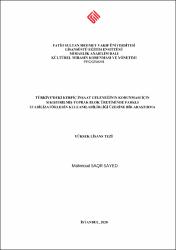| dc.contributor.advisor | Dabanlı, Ömer | |
| dc.contributor.author | Saqr Sayed, Mahmoud | |
| dc.date.accessioned | 2020-11-06T12:05:49Z | |
| dc.date.available | 2020-11-06T12:05:49Z | |
| dc.date.issued | 2020 | en_US |
| dc.identifier.citation | SAQR SAYED, Mahmoud, Türkiye'deki Kerpiç İnşaat Geleneğinin Korunması için Sıkıştırılmış Toprak Blok Üretiminde Farklı Stabilizatörlerin Kullanılabilirliği Üzerine Bir Araştırma, Fatih Sultan Mehmet Vakıf Üniversitesi Lisansüstü Eğitim Enstitüsü Mimarlık Anabilim Dalı, Yayımlanmamış Yüksek Lisans Tezi, İstanbul 2020. | en_US |
| dc.identifier.uri | https://hdl.handle.net/11352/3187 | |
| dc.description.abstract | Anadolu coğrafyası, binlerce yıl önce bu bölgeye gelen toplumların, kültürlerin ve medeniyetlerin etkisiyle zenginleşmiş ve bu çeşitli medeniyetler döneminde inşa edilmiş olan ve günümüzde de hala varlığını sürdüren birçok kerpiç yapıya ev sahipliği yapmaktadır. Büyük bir kültürel değere sahip olan ve bölgede geçmiş ile geleceği canlandıracak olan kerpiç mimari mirasının, bu kültürel ve mimari zenginlik ile korunması gerekmektedir. Diğer bir deyişle, taşınmaz kültürel varlıkların korunması ve sürdürülebilir bir şekilde geleceğe aktarılması önemli bir gerekliliktir.
Bu çalışmanın amacı, Türkiye’deki kerpiç yapıların somut ve soyut miras boyutları ile korunması için uyumlu ve sürdürülebilir bir giriş oluşturmak ve kerpiç yapımın modern tekniklerini kullanarak bu bölgelerde yeni binalar geliştirme olasılığını araştırmaktır.
Tezin birinci bölümünde, çalışmanın amacı, kapsamı ve yöntemi hakkında bilgi verilmiştir. İkinci bölümde, kerpiç mimari mirasının UNESCO mevzuatı ışığında sürdürülebilirlik ile çevresel ve mimari uyumluluk açısından ele alınmış. bunun yanı sıra, restorasyon ve teknolojinin entegrasyonu açısından kerpiç mimari ve somut miras ilişkisi incelenmiştir. Üçüncü bölümde, toprak bileşenleri ve bunların oluşturan faktörler ve çeşitli kil mineralleri üzerinde durulmuştur. Dördüncü bölüm ise, bir yapı malzemesi olarak toprak ve yapım yöntemleri hakkındadır. Beşinci bölüm’de laboratuvar çalışmaları, testler, analizler ve deneylerden elde edilen sonuçları verilmiştir. Altıncı bölümde, üretimin tüm aşamaları, numunelerin mekanik ve fiziki deneyleri ve deneylerin sonuçları ele alınmıştır. Yedinci bölüm, tez konusundaki çalışmalardan elde edilen sonuçları ve ortaya konulan önerileri kapsamaktadır. | en_US |
| dc.description.abstract | Anatolian geography has been enriched with the influence of several societies, cultures and civilizations that came to this region thousands of years ago. The geography is also home to many earthen buildings that were built during these civilizations and still exist today. The erthen architectural heritage, which will revive the past and the future in this geographical region, which has a great value, must be protected with it’s cultural and architectural richness. In other words, the protection and sustainable preservation of immovable cultural assets are an important requirement.
The aim of this study is to create a harmonious and sustainable entrance to protect the dimensions of the tangible and intangible heritage of earthen buildings in the Turkey and to investigate the possibility of developing new buildings in these regions using modern techniques of adobe construction.
In the first part of the thesis, information about the purpose, scope and method of the study is given. In the second part, earthen architecture is discussed in terms of sustainability and environmental and architectural compatibility in the light of UNESCO laws as intangible heritage. In addition, the relationship between erthen architecture and tangible heritage was examined in terms of restoration and integration of technology. In the third section, soil components and factors leading to their formation and various clay minerals are emphasized. The fourth part is on soil and construction methods as a building material. The fifth chapter also includes results from laboratory studies, tests, analyses and experiments. In the sixth section, all stages of production, mechanical and physical tests of the samples and the results of the tests are discussed. The seventh chapter includes the analysis of the results obtained from the thesis and the suggestions for further researches. | en_US |
| dc.language.iso | tur | en_US |
| dc.publisher | Fatih Sultan Mehmet Vakıf Üniversitesi, Lisansüstü Eğitim Enstitüsü | en_US |
| dc.rights | info:eu-repo/semantics/openAccess | en_US |
| dc.subject | Kerpiç | en_US |
| dc.subject | Sıkıştırılmış Kerpiç Blok | en_US |
| dc.subject | Kültürel Miras | en_US |
| dc.subject | Toprak | en_US |
| dc.subject | Earth Construction | en_US |
| dc.subject | Compressed Earth Block | en_US |
| dc.subject | Cultural Heritage | en_US |
| dc.subject | Soil | en_US |
| dc.title | Türkiye'deki Kerpiç İnşaat Geleneğinin Korunması için Sıkıştırılmış Toprak Blok Üretiminde Farklı Stabilizatörlerin Kullanılabilirliği Üzerine Bir Araştırma | en_US |
| dc.title.alternative | A Research on the Suitabilty Oof Different Stabilizers in Producing Compressed Earth Block For Preserving The Earthen Construction Heritage in Turkey | en_US |
| dc.type | masterThesis | en_US |
| dc.contributor.department | FSM Vakıf Üniversitesi, Lisansüstü Eğitim Enstitüsü | en_US |
| dc.relation.publicationcategory | Tez | en_US |
| dc.contributor.institutionauthor | Saqr Sayed, Mahmoud | |



















